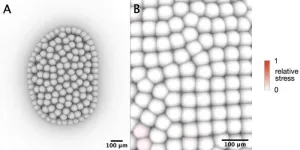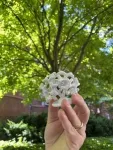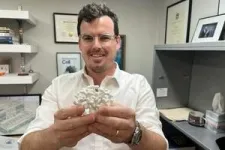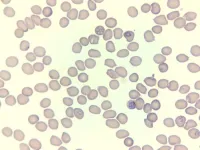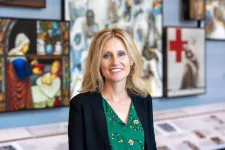(Press-News.org) To Alex Hughes, Assistant Professor in Bioengineering within Penn Engineering and in Cell and Developmental Biology within Penn Medicine, the kidney is a work of art. “I find the development of the kidney to be a really beautiful process,” says Hughes.
Most people only ever see the organ in cross-section, through textbooks or by dissecting animal kidneys in high school biology class: a bean-shaped slice with lots of tiny tubes. “I think that really undersells how amazing the structure is,” says Hughes, who points out that kidneys grow in utero like forests of pipes, branching exponentially.
The Rhythm of the Kidneys
Densely packed with tubules clustered in units known as nephrons, kidneys cleanse the blood, maintaining the body’s fluid and electrolyte balance, while also regulating blood pressure. The organ played a crucial role in vertebrates emerging from the ocean: as one paper puts it, kidneys preserve the primordial ocean in all of us.
Unfortunately, kidneys struggle in the modern world. Excessively salty food, being overweight, not exercising enough, drinking too much and smoking can all raise blood pressure, which damages the kidney’s tiny blood vessels, as does diabetes.
In some cases, damage to the kidney’s nephrons can be slowed with lifestyle changes, but, unlike the liver, bones and skin, which can regrow damaged tissue, kidneys have a limited capacity to regenerate. At present, without a transplant, the nephrons we have at birth must last a lifetime.
The Burden of Chronic Kidney Disease
Today, one in ten people worldwide — more than 850 million in all, including more than one in seven Americans — suffers from chronic kidney disease, or CKD. The condition is hard to initially detect. According to the Centers for Disease Control, as many as 90% of Americans with CKD are completely unaware of the condition. The disease is also progressive and incurable. By 2040, CKD is expected to be the fifth-leading cause of years of life lost globally.
Eventually, CKD leads to kidney failure, at which point there are only two treatments: dialysis — which costs tens of thousands of dollars per year, frequently causes pain and requires patients to spend hours each week hooked up to machines that filter the blood — or kidney transplantation. The waiting list to receive a new kidney in the United States is roughly 100,000 people and three to five years long.
Even if everyone born today adopted healthier lifestyles, millions would still suffer from the disease. The most common prenatal developmental abnormalities involve the kidneys and urinary tract, impacting 2% of all births, or nearly three million babies each year. “There is a huge clinical burden of kidney disease,” says Hughes. “And there are relatively few engineers trying to come up with new solutions.”
To that end, the Hughes Lab focuses on elucidating the mechanisms behind kidney development and using those insights to create kidney tissue from scratch, which could reduce the need for both dialysis and transplantation. “I think there’s just enormous opportunity to think about synthetically reconstituting kidney tissues for regenerative medicine,” says Hughes.
Building without a Blueprint
To grow artificial kidneys, researchers like Hughes first need to understand how nature builds the organ. This is harder than it sounds. Everyone’s heart and circulatory system look more or less the same, but no two pairs of kidneys are exactly alike.
Kidneys form as their tubules branch, a variable process that leads to some people’s kidneys having nine times as many nephrons as others — and potentially many more times the filtration power and lifespan. “There’s a lot of variability in how many nephrons we have,” Hughes points out, referring to the kidney’s tiny, functional unit. “If you have fewer nephrons, does that mean that you have a higher chance of chronic kidney disease? The research seems to support this.”
The mechanisms that govern that branching process and nephron formation have long been poorly understood. “It’s like a city’s water distribution network,” says Hughes, “but it’s being built by these cells that somehow collectively know what to build and where their neighbors are and what junctions to make, all without a blueprint.”
In a recent paper in Nature Materials, Hughes and his lab discovered a potential governor of kidney growth: tiny mechanical stress waves, which occur when the kidney’s densely packed tubules bump into one another. “Imagine being in an elevator and the elevator’s packed with people already,” says Hughes. “If you keep adding people, it will create this mechanical stress— you’d literally be pushing people away with your elbows.”
Hughes and his collaborators — including co-first authors Louis Prahl, a postdoctoral scholar in the Hughes Lab, Jiageng Liu, a Bioengineering doctoral student, and John Viola, a Bioengineering Ph.D. graduate — carefully analyzed microscopic images of developing animal kidneys at different times to determine their geometry and pressed on the organs with tiny tools to measure their rigidity. The more tightly packed the tubules, which increases over time, the stiffer the tissue. As tubule branching continues, they found that each additional branch caused a pulse of mechanical stress, which the team believes may constitute one of the signals for nephron formation.
Each tubule, Hughes’ group concluded, essentially competes for space with its neighbors. In other words, there’s no master plan the kidneys follow, helping to explain why the number of nephrons in mature kidneys differs from person to person. The finding suggests that kidney development is something like an improvised dance, with each tubule reacting to the touch of its neighbors.
In videos created by the Hughes Lab to visualize the process, adjacent nephrons form one after the other, as if they were following a beat. “It’s still a hypothesis,” adds Hughes, “but we think that the stem cells that are around these tubules are effectively listening for these mechanical stress waves to guide their decision making about when to form a nephron or when not to.” If researchers can simulate that rhythm, they might be able to guide the development of artificial kidneys, which would represent a tremendous leap forward in treating CKD.
The Right Ingredients
At the moment, artificial kidney tissue — in the form of clusters of cells known as organoids — is far from clinical usefulness. Whereas normal kidneys involve an ordered collection of different cell types, organoids typically wind up as chaotic masses of cells in the wrong places. “You can create the right cell types,” says Hughes, “but their spatial organization is incorrect for the most part.”
Kidneys’ spatial organization is crucial — a water filtration plant can’t work if the pipes don’t line up. Unfortunately, the tubules in organoids typically display insufficient branching and fail to drain into a single exit point. In other words, they can’t fulfill the kidney’s most crucial functions: filtering waste from the blood and ensuring that waste exits the body. “There needs to be a lot of engineering innovation in how we guide those tissues to be more lifelike,” says Hughes.
Part of the problem is that kidney organoids require at least three different types of stem cells: one for the tubules, one for the nephrons and one for support structures like blood vessels. Unlike, say, gut organoids, which model intestinal tissue and can be grown from a single type of stem cell, kidney organoids are inherently more complicated.
In a second recent paper, in Cell Systems, the Hughes Lab proposed a novel solution: create tiny communities of the various cell types, patterned in a mosaic. By adjusting the ratios of each stem cell type, the researchers were able to influence the composition of the organoid.
Hughes and his coauthors — first author Catherine Porter and Samuel Grindel, both Bioengineering doctoral students, and Grace Qian, a 2023 Bioengineering graduate and current doctoral student at the University of California Berkeley and University of California San Francisco — developed custom microwells, in which they grew a variety of different combinations of kidney stem cells, almost like bakers trying out different recipes.
As the ratios changed, the researchers noticed a “peak” in tubule formation, suggesting an optimal composition for growing kidney tissue, which they termed the “goldilocks” ratio. “If we change the ratio, we see quite different compositions of the organoid,” says Hughes. “So you can treat these as designer organoids where you have control over the outcome.”
From Lab to Clinic
Ultimately, Hughes hopes to combine these dual insights — into the mechanical stress waves that influence kidney development, and the ratios that shape organoid formation — into clinical applications. “You can imagine as these organoids are differentiating,” he says, “you could simulate that rhythmic process and see if suddenly you can kick off a larger-scale outcome.”
The urgency of developing alternatives to transplantation and dialysis is hard to overstate. At present rates, there will never be enough kidneys for transplantation. “I think that’s a big gap that engineers can hope to fill,” says Hughes. In his office, he keeps his great-grandfather’s pocket watch, a reminder of how function and form go hand in hand when it comes to designing intricate mechanical objects. The watch still runs.
These studies were conducted at the University of Pennsylvania School of Engineering and Applied Science and supported by the National Science Foundation (DMR-2309043 and CAREER Awards 2339278 and 2047271) and National Institutes of Health National Institute of General Medical Sciences (R35GM133380), National Institute of Diabetes and Digestive and Kidney Diseases (R01DK132296), and Eunice Kennedy Shriver National Institute of Child Health and Human Development (K25HD097288 and R21HD112663).
Additional co-authors of the papers referred to include Aria Zheyuan Huang, Trevor J. Chan, Gabriela Hayward-Lara and Catherine M. Porter of Penn Engineering, and Chenjun Shi and Jitao Zhang of Wayne State University.
END
Developing kidneys from scratch
Alex Hughes tackles the tremendous burden of kidney disease
2024-10-28
ELSE PRESS RELEASES FROM THIS DATE:
Airbnbs associated with more crime in London, new study shows
2024-10-28
Since its founding in 2008, the short-term homestay platform Airbnb has expanded to 100,000 cities in more than 220 countries, and, according to data from the company, 1.5 billion guests had stayed in Airbnb-listed properties through 2023.
Much of the academic research on Airbnb activity comes from economics and business literature and focuses on housing-supply impacts, says David Kirk, professor of criminology at the University of Pennsylvania. Yet research on neighborhood impacts is limited, and that research neglects the impacts of Airbnb activity on measures of community cohesion and safety.
Kirk teamed with University of Cambridge criminologist ...
New study finds invasive plants drive homogenization of soil microbial communities across U.S.
2024-10-28
Invasive plants are doing more than just taking over landscapes — they’re also changing the soil beneath them. A new study co-authored by Matthew McCary, assistant professor of biosciences at Rice University, reveals that these species are reshaping soil microbial communities across the U.S., making them more uniform and altering how ecosystems function. The findings, published in Proceedings of the National Academy of Sciences on Oct. 24, shed light on the far-reaching impacts of invasive plants, which extend beyond what we see above ground.
The ...
Researchers’ new outreach strategy succeeds, sets blueprint for detecting invasive species in Florida
2024-10-28
Invasive species in Florida like Nile monitors and Argentine black-and-white tegus pose a growing threat to the Sunshine State’s environment, economy and public safety. South Florida’s warm climate, disturbed habitats and bustling pet trade have made it a hotspot for these non-native, cryptic reptiles. However, finding these elusive creatures has always been a challenge – until now.
University of Florida researchers are showcasing how a focused outreach initiative in Palm Beach County has led to a successful increase in reports of invasive reptiles in Florida. The findings are documented in the latest study published in Scientific Reports and authored by researchers at UF/IFAS ...
Discovery of critical iron-transport protein in malaria parasites could lead to faster-acting medications
2024-10-28
Malaria kills over 600,000 people a year, and as the climate warms, the potential range of the disease is growing. While some drugs can effectively prevent and treat malaria, resistance to those drugs is also on the rise.
New research from University of Utah Health has identified a promising target for new antimalarial drugs: a protein called DMT1, which allows single-celled malaria parasites to use iron, which is critical for parasites to survive and reproduce.
The results suggest that medications that block DMT1 might be very effective against malaria.
The new results are published in PNAS.
An ironic mystery
Paul Sigala, ...
Risky choices: How US laws affect migrant children’s journeys to border
2024-10-28
U.S. immigration law and the legal categorizations it imposes on migrants shape the journeys of migrant children from Central America as they move through Mexico toward the southern U.S. border, according to a new Yale study.
In the study, sociologist Ángel Escamilla García documents the various hard decisions Central American youth are forced to make during their journeys to maximize their chances of not being deported once they reach the United States. Those choices include concealing sexual assaults, beatings, and other crimes ...
Scientists address risks to supply chain in a connected world
2024-10-28
RICHLAND, Wash.—Scientists are gathering at the Department of Energy’s Pacific Northwest National Laboratory this week for a first-ever conference to consider ways to protect critical systems such as our electrical grid, water treatment plants and financial networks that are vulnerable in new ways.
The Cyber Supply Chain Risk Management Conference, known as CySCRM 2024, is being held on the PNNL campus Tuesday-Wednesday, Oct. 29-30.
It’s a new kind of science meeting, one that scientist Jess Smith and colleagues felt compelled to create as they eye a new kind of risk—a ...
Don’t skip colonoscopy for new blood-based colon cancer screening, study concludes
2024-10-28
Newly available blood tests to screen for colorectal cancer sound far more appealing than a standard colonoscopy. Instead of clearing your bowels and undergoing an invasive procedure, the tests require only a simple blood draw. But are the tests effective?
A study led by researchers at Stanford Medicine concluded that the new tests are ideal for people who shy away from other colorectal cancer screening. However, if too many people who would have undergone colonoscopies or stool-based tests switch to the blood tests, colorectal cancer death rates will rise. Because the more established colonoscopies and stool tests ...
Up to half of Medicare beneficiaries lack financial resources to pay for a single hospital stay
2024-10-28
Embargoed for release until 5:00 p.m. ET on Monday 28 October 2024
@Annalsofim
Below please find summaries of new articles that will be published in the next issue of Annals of Internal Medicine. The summaries are not intended to substitute for the full articles as a source of information. This information is under strict embargo and by taking it into possession, media representatives are committing to the terms of the embargo not only on their own behalf, but also on behalf of the organization they represent. ...
Chemicals produced by fires show potential to raise cancer risk
2024-10-28
Derek Urwin has a special stake in his work as a cancer control researcher. After undergraduate studies in applied mathematics at UCLA, he became a firefighter. His inspiration to launch a second career as a scientist was the loss of his brother, Isaac, who died of leukemia at only 33 despite no history of cancer in their family. Working with Anastassia Alexandrova, a professor of chemistry and biochemistry in the UCLA College, he earned his doctorate.
Urwin is now a UCLA adjunct professor of chemistry — and still a full-time firefighter with the Los Angeles County Fire Department. In a recent publication, his science shed new light on the chemical underpinnings of exposures ...
Penn Nursing awarded $3.2 million grant to improve firearm safety
2024-10-28
PHILADELPHIA (October 28, 2024) – The University of Pennsylvania School of Nursing (Penn Nursing) has been awarded a $3.2 million, 5-year grant from the National Institute of Nursing Research (NINR) to scale out an evidence-based secure firearm storage intervention at Children’s Hospital of Philadelphia (CHOP). Firearms are now the leading cause of death for U.S. children and teens, driving the largest spike in children’s mortality in more than 50 years. The study aims to keep children safer from firearm injury and mortality by promoting secure firearm storage.
The intervention, ...
LAST 30 PRESS RELEASES:
Ambitious model fails to explain near-death experiences, experts say
Multifaceted effects of inward foreign direct investment on new venture creation
Exploring mutations that spontaneously switch on a key brain cell receptor
Two-step genome editing enables the creation of full-length humanized mouse models
Pusan National University researchers develop light-activated tissue adhesive patch for rapid, watertight neurosurgical sealing
Study finds so-called super agers tend to have at least two key genetic advantages
Brain stimulation device cleared for ADHD in the US is overall safe but ineffective
Scientists discover natural ‘brake’ that could stop harmful inflammation
Tougher solid electrolyte advances long-sought lithium metal batteries
Experts provide policy roadmap to reduce dementia risk
New 3D imaging system could address limitations of MRI, CT and ultrasound
First-in-human drug trial lowers high blood fats
Decades of dredging are pushing the Dutch Western Scheldt Estuary beyond its ecological limits
A view into the innermost workings of life: First scanning electron microscope with nanomanipulator inaugurated in hesse at Goethe University
Simple method can enable early detection and prevention of chronic kidney disease
S-species-stimulated deep reconstruction of ultra-homogeneous CuS nanosheets for efficient HMF electrooxidation
Mechanical and corrosion behavior of additively manufactured NiTi shape memory alloys
New discovery rewrites the rules of antigen presentation
Researchers achieve chain-length control of fatty acid biosynthesis in yeast
Water interactions in molecular sieve catalysis: Framework evolution and reaction modulation
Shark biology breakthrough: Study tracks tiger sharks to Maui mating hub
Mysterious iron ‘bar’ discovered in famous nebula
World-first tool reduces harmful engagement with AI-generated explicit images
Learning about public consensus on climate change does little to boost people’s support for action, study shows
Sylvester Cancer Tip Sheet for January 2026
The Global Ocean Ship-Based Hydrographic Investigations Program (GO-SHIP) receives the Ocean Observing Team Award
Elva Escobar Briones selected for The Oceanography Society Mentoring Award
Why a life-threatening sedative is being prescribed more often for seniors
Findings suggest that certain medications for Type 2 diabetes reduce risk of dementia
UC Riverside scientists win 2025 Buchalter Cosmology Prize
[Press-News.org] Developing kidneys from scratchAlex Hughes tackles the tremendous burden of kidney disease
